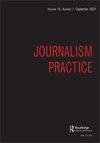Media Discourses and Representation of Marginalized Communities in Multicultural Societies
IF 2
2区 文学
Q2 COMMUNICATION
引用次数: 0
Abstract
Albeit an increase in awareness of minority problems, people from immigrant, ethno-cultural, and diverse racial groups or who are lesbian, bisexual, gay, or transgender or who are from low-income groups, do not have the same access to media like majority members of the society. In any democratic society, circumstances like this should not be marginalized because news cannot be perceived merely as commodity for lucid public discourse, but as the public construction of exact images of society. This implies that one of the central problems to address when scrutinizing the contribution of the news media in community-building is its relationship to cultural diversity. Although representation and visibility of minorities in mass media, reflects just one of several factors related with the standing of minority groups in society, its influence should not be underestimated. Both theory and empirical research on media discourse, suggests that stereotypes arise from and are maintained via interaction with the messages offered in mass media fare. Journalists and media professionals, in many parts of the world, replicates part of the everyday biased practices against members of marginalized communities, whether in pejorative, offensive and abusive texts or speeches, or by way of other strategies employed for marginalization and barring from media discourses. Often, minority members are depicted through a negative lens by the news media and most usually as a homogenous group rather than as individuals. In addition, they are scarcely visible in news media, either through exclusion from majority establishment or through self-invisibility practices. In contrast, the news media also produce discourses that attempt to identify the difficulties regarding discrimination and social exclusion of members of marginalized communities, and they struggle to fight for equal human rights. In any case, the news media have a deep effect on their audiences and should be prudently considered in matters of representation and visibility of minorities. “Media discourses and Marginalized Communities in Multicultural Societies” is Journalism Practice’s special edition with a purpose to present studies offering insights into the news media’s role in jeopardizing the representation of minority/or marginalized groups, as well as to address their potential role to combat discrimination against members of marginalized groups such as minority racial and ethnic communities, asylum seekers, migrants, sex workers, LGBT persons, and rape victims. The term media discourses does多元文化社会中边缘化群体的媒介话语与表现
尽管对少数群体问题的认识有所提高,但来自移民、民族文化和不同种族群体的人、女同性恋者、双性恋者、男同性恋者、变性者或来自低收入群体的人,与社会大多数成员相比,没有同样的机会接触媒体。在任何民主社会,这样的情况都不应该被边缘化,因为新闻不能仅仅被视为清晰的公共话语的商品,而是作为对社会准确形象的公共建构。这意味着,在审视新闻媒体对社区建设的贡献时,需要解决的核心问题之一是它与文化多样性的关系。虽然少数群体在大众传播媒介中的代表性和知名度只是反映了与少数群体在社会中的地位有关的几个因素之一,但其影响不应被低估。关于媒体话语的理论和实证研究都表明,刻板印象产生于大众媒体所提供的信息,并通过与大众媒体所提供的信息的相互作用而得以维持。在世界许多地方,记者和媒体专业人员复制了对边缘化社区成员的部分日常偏见做法,无论是在轻蔑、冒犯和辱骂的文本或演讲中,还是通过采取其他策略来边缘化和禁止媒体话语。通常,新闻媒体通过负面的镜头描绘少数民族成员,通常是作为一个同质群体而不是作为个人。此外,他们在新闻媒体中几乎看不到,要么是由于被排除在主流机构之外,要么是由于自我隐形的做法。相比之下,新闻媒体也发表言论,试图指出歧视和社会排斥边缘化社区成员的困难,并努力争取平等的人权。无论如何,新闻媒介对其受众有深刻的影响,在少数群体的代表性和知名度方面应谨慎考虑。“多元文化社会中的媒体话语和边缘化群体”是《新闻实践》的特别版,旨在通过研究,深入了解新闻媒体在损害少数群体或边缘化群体的代表性方面所起的作用,并探讨新闻媒体在打击对少数种族和族裔群体、寻求庇护者、移民、性工作者、LGBT群体和强奸受害者等边缘化群体成员的歧视方面的潜在作用。“媒体话语”这个词就是
本文章由计算机程序翻译,如有差异,请以英文原文为准。
求助全文
约1分钟内获得全文
求助全文
来源期刊

Journalism Practice
COMMUNICATION-
CiteScore
5.50
自引率
14.30%
发文量
111
期刊介绍:
ournalism Practice provides opportunities for reflective, critical and research-based studies focused on the professional practice of journalism. The emphasis on journalism practice does not imply any false or intellectually disabling disconnect between theory and practice, but simply an assertion that Journalism Practice’s primary concern is to analyse and explore issues of practice and professional relevance. Journalism Practice is an intellectually rigorous journal with all contributions being refereed anonymously by acknowledged international experts in the field. An intellectually lively, but professionally experienced, Editorial Board with a wide-ranging experience of journalism practice advises and supports the Editor. Journalism Practice is devoted to: the study and analysis of significant issues arising from journalism as a field of professional practice; relevant developments in journalism training and education, as well as the construction of a reflective curriculum for journalism; analysis of journalism practice across the distinctive but converging media platforms of magazines, newspapers, online, radio and television; and the provision of a public space for practice-led, scholarly contributions from journalists as well as academics. Journalism Practice’s ambitious scope includes: the history of journalism practice; the professional practice of journalism; journalism training and education; journalism practice and new technology; journalism practice and ethics; and journalism practice and policy.
 求助内容:
求助内容: 应助结果提醒方式:
应助结果提醒方式:


